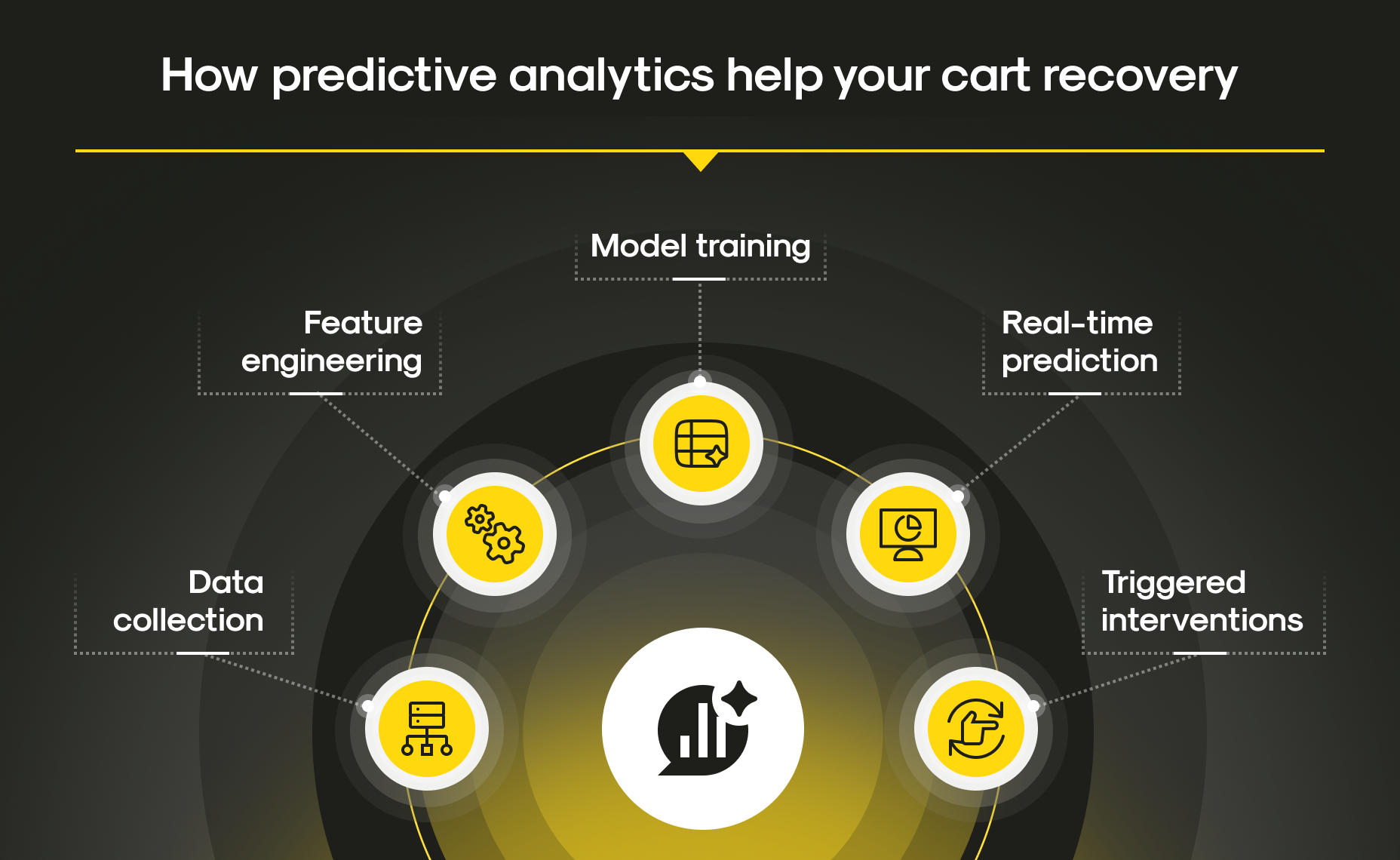Modern online retailers face a frustrating paradox: thousands of users browse, select products, and carefully fill their shopping carts, only to leave before completing the purchase. This phenomenon, known as cart abandonment, costs ecommerce businesses billions annually. Industry reports estimate the global average cart abandonment rate at around 70%, which means for every ten potential sales, only three make it through.
But why does this happen? Sometimes shoppers are distracted, sometimes they’re just window-shopping, and often they’re hesitating due to price, shipping costs, or lack of trust. While traditional marketing solutions like generic retargeting emails or blanket discounts try to bring customers back, they rarely address the root cause of abandonment at the individual level.
This is where AI-driven predictive engagement comes in. By analyzing user behavior in real-time (using tools similar to Google Analytics, Hotjar, or custom machine learning models) AI can calculate the probability that a given shopper will abandon their cart. More importantly, it can intervene proactively: offering targeted discounts, free shipping, or personalized recommendations designed to tip the scale toward conversion. In this article, you’ll learn:
- How AI predicts which shoppers are likely to abandon their carts using real-time behavioral signals and historical data.
- Why traditional solutions like blanket discounts or retargeting ads often fail and can erode margins.
- How the Next Best Offer (NBO) model enables personalized interventions, from dynamic discounts to product recommendations.
- The technology behind predictive engagement, including data collection, feature engineering, machine learning models, and real-time decision engines.
- Key considerations and challenges, including privacy, over-discounting, user experience, and integration complexity.
- Best practices for implementing AI-driven cart recovery that maximizes revenue while maintaining trust and a seamless customer experience.
Why traditional methods fall short
Retailers have long tried to solve cart abandonment with static solutions:
- Pop-ups offering 10% off for everyone.
- Blanket free shipping campaigns.
- Retargeting ads that follow users across the internet.
While these strategies sometimes work, they’re inefficient. Offering discounts to all users erodes margins unnecessarily. Retargeting often feels intrusive and leads to banner blindness. And most importantly, these methods don’t distinguish between a customer who was seconds away from buying versus one who never had serious purchase intent.
Without personalization, businesses leave money on the table, either by losing potential buyers or overspending to convert those who would have purchased anyway.
How AI predicts cart abandonment
AI-powered engagement platforms take a different approach. Instead of treating all shoppers the same, they evaluate each session based on real-time behavioral signals.
For example, AI can detect patterns like:
- Time spent on checkout pages. Long hesitation may signal doubts.
- Mouse movement and scrolling heatmaps. Erratic or repeated hovering over “Shipping costs” or “Payment options” often means friction.
- Device and session data. Mobile shoppers are more likely to abandon due to poor UX or distractions.
- Cart composition. High-value or bulky items may trigger concerns about shipping costs.

How predictive analytics help your cart recovery
By combining these micro-signals with historical data (e.g., past purchases, browsing frequency), AI models can assign a probability score: how likely this user is to complete or abandon the purchase.
This is essentially Next Best Offer (NBO) modeling, a predictive analytics technique widely used in marketplaces. Just as AI predicts the most relevant product or service for upselling, here it predicts the most effective intervention to prevent abandonment.
The NBO model: the overview
Retail has always thrived on personal relationships, and sometimes so much that shoppers preferred buying from a particular salesperson rather than the brand itself. Today, the challenge is bringing that same personal touch into the digital world. This is where AI-powered Next Best Offer (NBO) solutions come in.
How it works in practice
Take an online clothing store as an example. By integrating data from multiple devices into a Customer Data Platform (CDP), NBO algorithms can analyze customer behavior and find patterns across users. If clients with similar habits purchase the same products, the system can suggest additional items that others like them bought. In short, it’s like having a personal shopping assistant that knows what you might want next.
Step 1. Define your goals
Before implementing an NBO system, clarify what you want to achieve:
- Attract new clients
- Boost sales
- Reduce churn
- Increase loyalty or tackle another specific business challenge.
Step 2. Collect data
Data is the backbone of NBO. Here’s a classic example from Walmart: by analyzing shopping patterns through in-store Wi-Fi, they discovered that customers who bought beer often bought diapers too. Rearranging the store layout to reflect this correlation increased sales of both products by 30%.
To collect and manage data effectively, implement a CDP that gathers information from your website, store, and CRM, then organizes it for easy analysis.
Step 3. Analyze and implement NBO
One thing is certain: numbers alone don’t drive decisions, you need actionable insights. Use segmentation and data modeling to tailor offers to customer behavior. For example:
- A customer who prefers in-store shopping and spends, say, 100 dollars, will a 15-dollar discount for online purchases motivate them, or would SMS coupons for physical stores be more effective?
- How would the same offer perform for a customer who mainly shops online?
Answering these questions early ensures your NBO strategy is both relevant and impactful.
Step 4. Monitor and adapt
Launching NBO isn’t the end: continuous monitoring and analysis are crucial. Customer preferences, market conditions, and competitor strategies evolve, and your NBO system should evolve too, ensuring your recommendations stay timely and effective.
Smart interventions: from discounts to free shipping
Once AI detects that a customer is at risk of abandoning their cart, it can trigger tailored engagement in real time. These interventions go beyond generic promotions:
- Dynamic discounts. Instead of blasting 10% off to everyone, AI can calculate the minimum effective discount to convert a particular user. For instance, if analytics show that a shopper has previously purchased at full price, they might only need a 5% nudge. Conversely, a first-time visitor comparing multiple competitors may require a steeper incentive.
- Free shipping offers. High shipping costs remain one of the top reasons for cart abandonment. If AI detects that the shipping calculator is a bottleneck, it can offer free or reduced shipping right at the moment of hesitation.
- Personalized product recommendations. According to statistics, 49% of customers make an unplanned purchase of a product because they received a personal recommendation. What does this mean? Well, sometimes abandonment isn’t about price but uncertainty. AI can recommend similar products, bundles, or alternatives that match the shopper’s browsing history, helping them find exactly what they want.
- Urgency and social proof messages. Predictive models can trigger subtle nudges like “Only 3 items left in stock” or “12 people bought this today.” When used judiciously, these signals can reduce hesitation without feeling manipulative.
- Checkout assistance. For high-value purchases, AI-powered chatbots can step in to answer last-minute questions, offer flexible payment options, or even schedule a call with a sales assistant.
By tailoring interventions to the individual shopper’s risk profile, businesses can convert more carts without over-discounting.
The technology behind the magic
While the business impact is clear, let’s break down the mechanics of such systems. Predictive engagement relies on:
- Data collection. Tracking browsing, clicks, time on page, cart details, and historical customer data.
- Feature engineering. Turning raw behavior (e.g., “hovered over shipping link for 8 seconds”) into meaningful variables.
- Machine learning models. Training classification or regression models to predict abandonment probability. Logistic regression, gradient boosting, and deep learning models are commonly used.
- Real-time decision engines. Systems that trigger actions (discounts, pop-ups, chatbot messages) in milliseconds when risk thresholds are met.
In 2025, modern solutions often integrate with platforms like Shopify, Magento, or custom ecommerce stacks. Some retailers build their own models, while others use SaaS products specializing in AI-driven personalization.
Challenges and considerations
Nowadays, AI-powered engagement tools promise personalized experiences, higher conversions, and smarter marketing, but they aren’t magic. Retailers need to navigate several pitfalls to ensure their AI initiatives truly enhance customer relationships rather than backfire:
- Overfitting discounts. If users realize they get a discount simply by lingering at checkout, they may exploit the system. Businesses must fine-tune thresholds and keep interventions unpredictable.
- Privacy and compliance. Behavioral tracking must comply with GDPR, CCPA, and other privacy regulations. Transparency in data usage is key to maintaining trust.
- Balance between help and intrusion. Overly aggressive pop-ups or pushy chatbot messages can harm UX. AI should feel like assistance, not surveillance.
- Integration complexity. Smaller retailers may lack the technical resources to implement custom AI models. SaaS-based predictive engagement tools can bridge this gap.
Key takeaway
To cut a long story short, AI-driven engagement can boost personalization and revenue, but only when implemented thoughtfully. Respect user privacy, avoid predictable incentives, maintain a helpful rather than intrusive presence, and choose tools that match your technical capabilities. Smart deployment ensures AI supports customers and business goals alike.
The future of cart recovery
The next wave of AI engagement will move beyond reactive interventions. We’ll see:
- Voice-assisted checkout. AI helping users complete purchases hands-free.
- Emotion recognition. Using sentiment analysis from a webcam or voice (opt-in) to detect frustration and step in.
- Cross-platform engagement. Predicting abandonment not only on a website but across email, social media, and in-app behavior.
Ultimately, the goal is the same: make online shopping frictionless and trustworthy, ensuring that every cart has the best possible chance of reaching checkout.
Key takeaway
The future of AI engagement is proactive, seamless, and customer-centric. By leveraging voice assistance, emotion recognition, and cross-platform insights, retailers can reduce friction, anticipate needs, and build trust, turning more browsing sessions into completed purchases while creating a shopping experience that feels effortless and personalized.
How Mitrix can help
Mitrix specializes in building AI-powered personalization systems that combine advanced recommendation models with human-like conversational experiences. From integrating AR try-on capabilities to designing privacy-first consent flows, Mitrix ensures that every interaction is meaningful, measurable, and on-brand. Our platform supports identity resolution across channels, real-time data processing, and attribution tracking, enabling retailers to both prove and improve their personalization ROI.
At Mitrix, we build AI agents designed around your needs, whether you’re looking to boost customer support, unlock insights from data, or streamline operations. Let’s create a robust AI agent tailored to transform your business!
Customer support agent
Delivers 24/7 customer assistance, resolves inquiries efficiently, addresses issues, and enhances overall customer satisfaction.
Healthcare assistant
Performs preliminary symptom assessments, organizes patient records, and provides accurate medical information.
Financial advisor
Delivers tailored investment advice, monitors market trends, and creates personalized financial plans.
Sales agent
Identifies and qualifies leads, streamlines sales processes, and drives growth by strengthening the sales pipeline.
Data analysis agent
Processes and interprets large datasets, delivers actionable real-time insights, and aids in strategic decision-making.
Virtual assistant
Organizes schedules, manages tasks, and provides timely reminders to enhance productivity.
Whether you’re coordinating international freight, managing warehouse logistics, or optimizing last-mile delivery, Mitrix can help build the chatbot system to match. Contact us today to discuss your virtual assistant!
Summing up
As of today, cart abandonment is one of the biggest profit leaks in ecommerce, but also one of the most solvable. Instead of throwing generic discounts at the problem, retailers can use , to identify at-risk shoppers in real time and deliver the exact incentive needed to secure the sale.
By combining behavioral analysis with machine learning models, businesses can reduce abandonment rates, protect margins, and create a smoother customer experience. As predictive analytics tools become more accessible, smart AI engagement is poised to become the standard for ecommerce success. The message is clear: if you want fewer empty carts and more completed checkouts, AI is the competitive edge you can’t afford to ignore.


